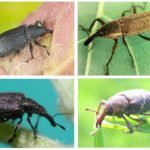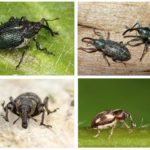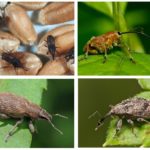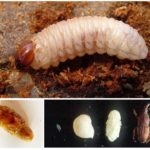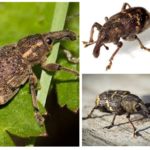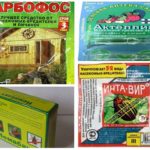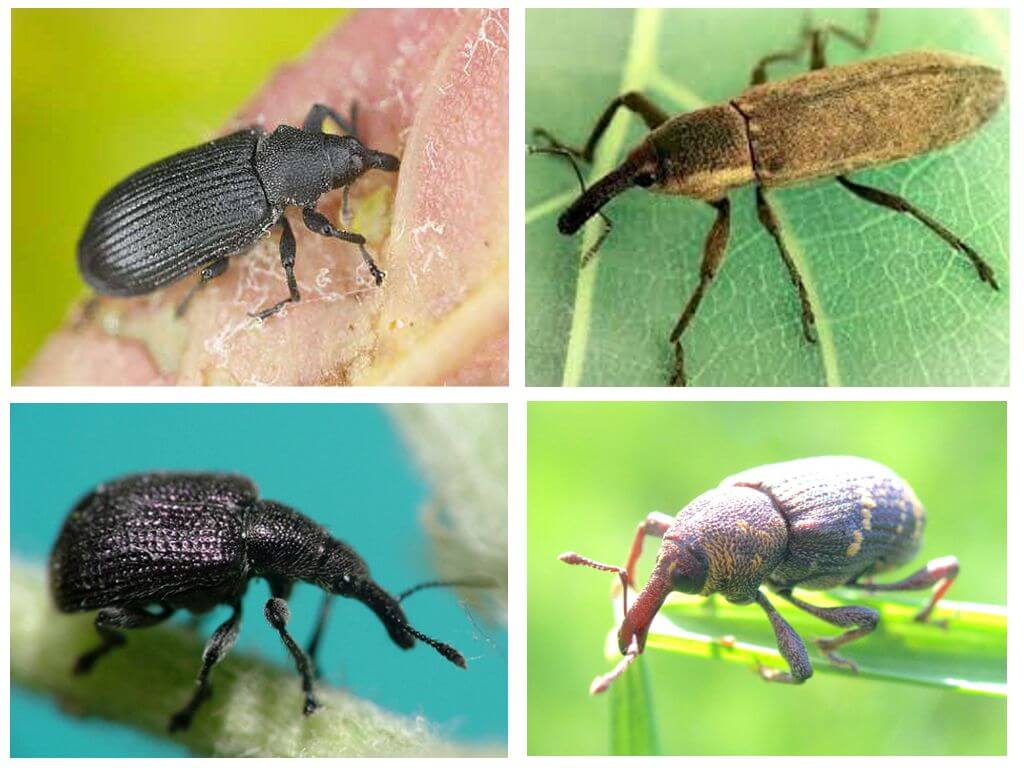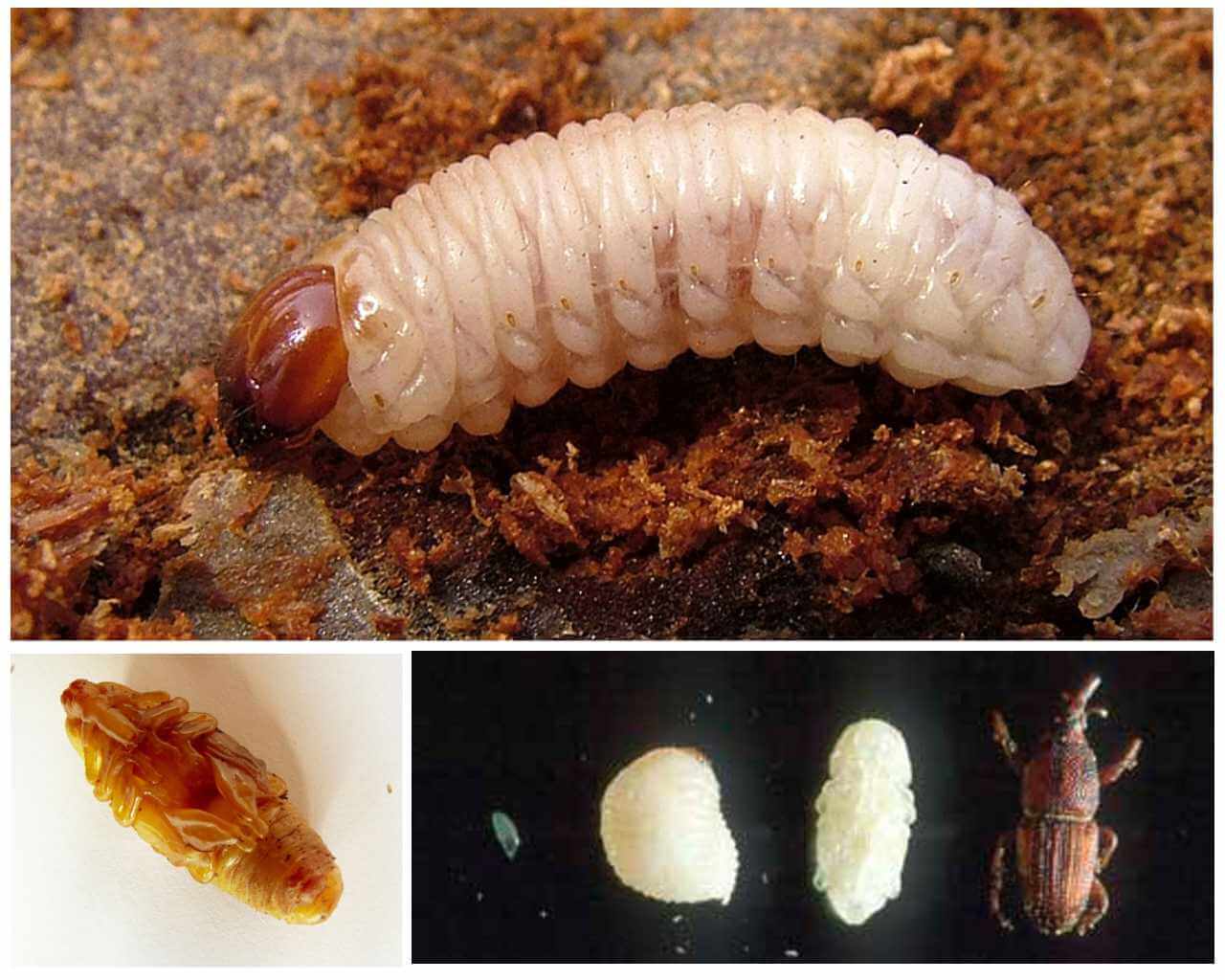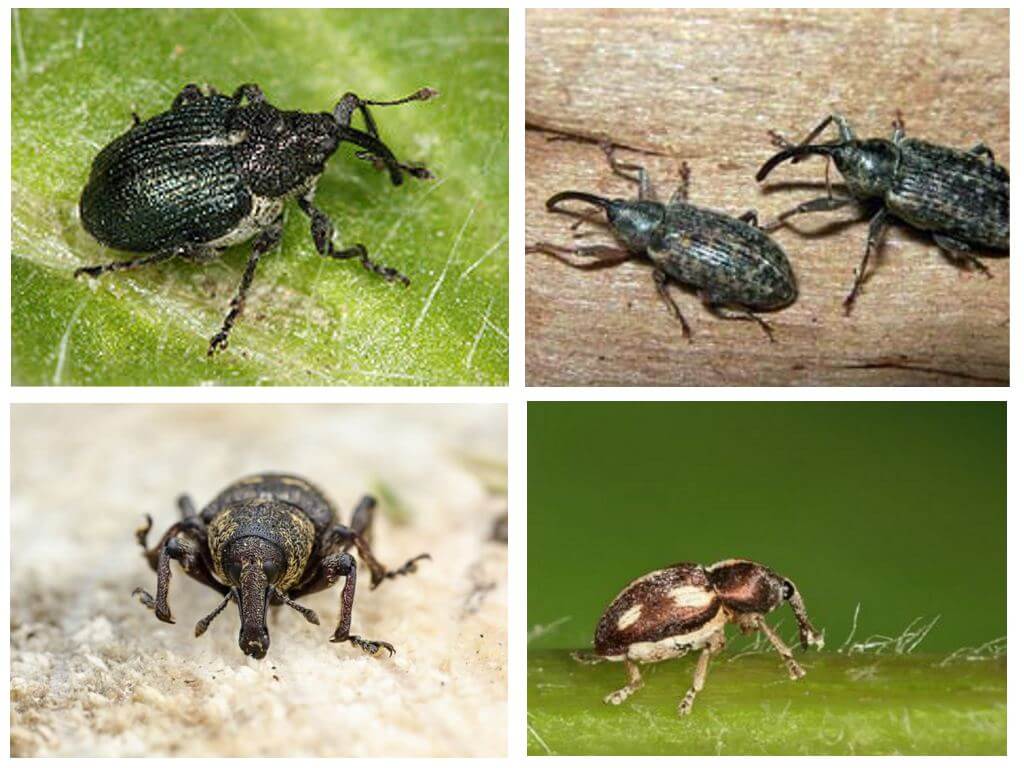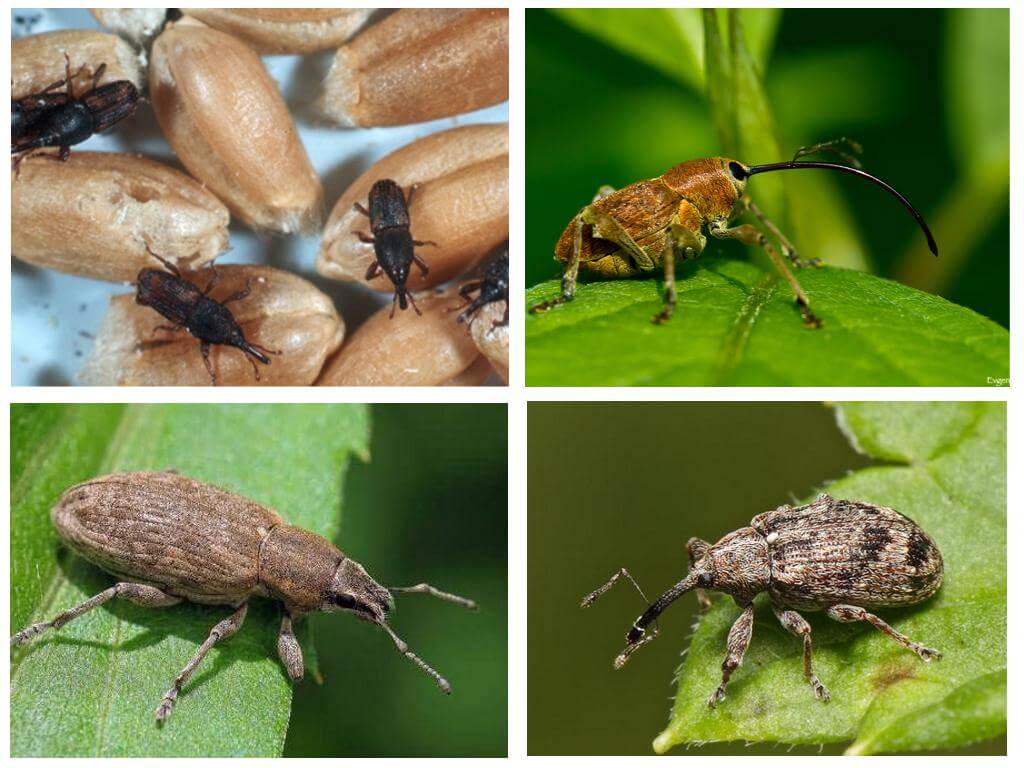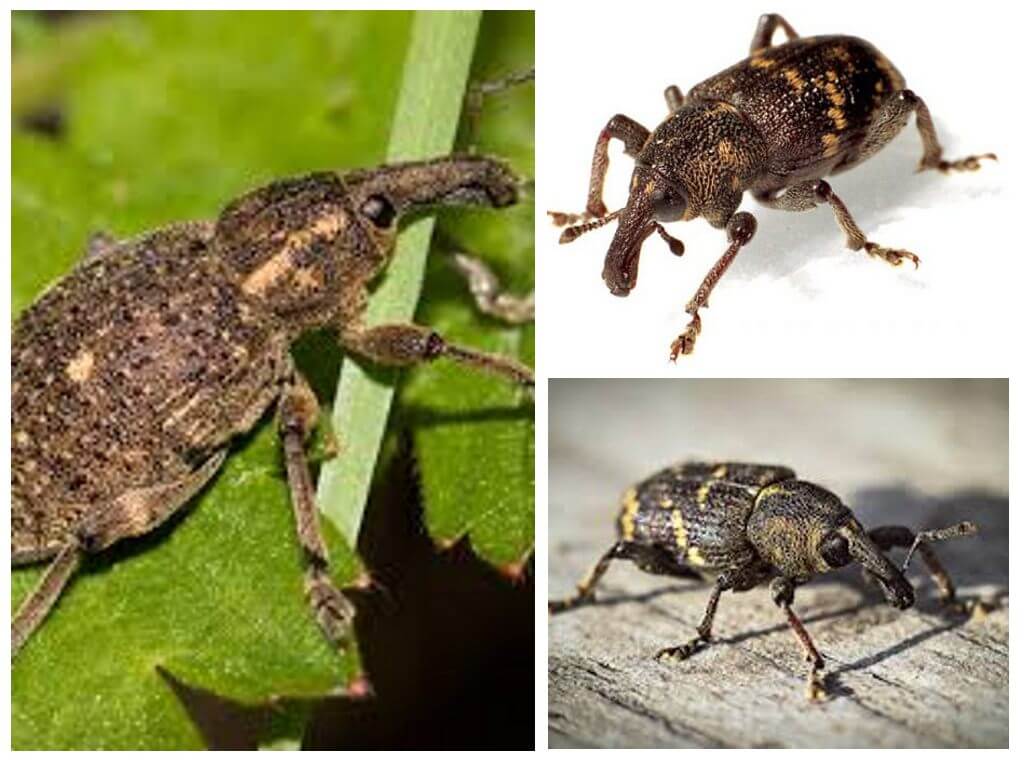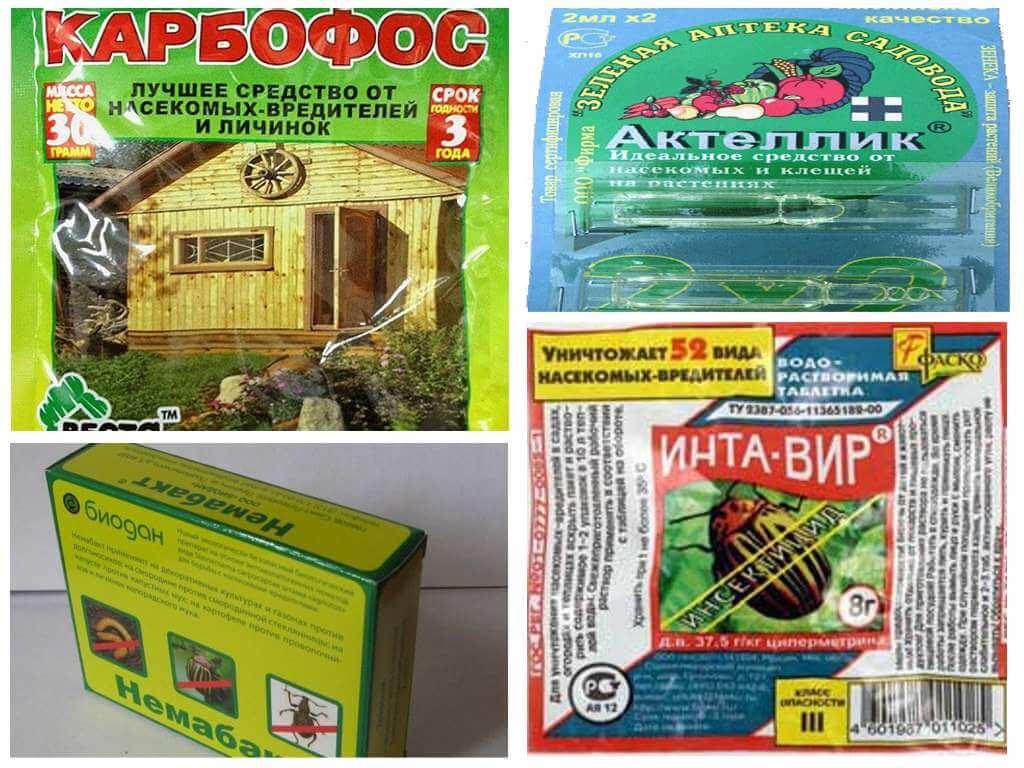Beetle weevil and its larvae
Content
- Weevils
- Weevils
- Weevil species
- Weevil larvae
- Weevils
- Weevils Remedies
The appearance of the weevil beetle
Weevil belongs to the class of insects. Most of them are small bugs, reaching a few millimeters in length. Only tropical representatives differ in gigantic sizes, reaching up to 50-60 mm. According to the description of the appearance of adult individuals are very diverse. Depending on the species, weevil beetles can be divided into the following groups:
- In size.
- According to the shape of the body, diamond-shaped, spherical, pear-shaped and rod-shaped insects are distinguished.
- By the color of chitinous cover, they can be of almost any color. Some individuals have a specific pollen coating or flake cover.
The whole family of weevils can be divided according to such characteristics, depending on the structure of the front of the head, called the robe:
- Short-nosed - the rostrum is small in size, which does not exceed two lengths of the width of its base. The larvae of elephants mostly live in the ground.
- Long-nosed - the cap is long, often curved and thinned to the top. Larvae prefer to be placed on the leaves or on the surface parts of plants.
The oral apparatus of adults is located at the end of the proboscis. In special apical grooves, cranked antennae with a characteristic mace are attached. A female weevil may look larger than a male. Although there are species that do not have external sex differences. An adult female gnaws a hole in the tissues of the stems, leaves, and lays eggs there. The size of one clutch can reach three dozen units. Long-stalked representatives most often lay eggs in nuts, apples and other fruits.
The larvae of the weevil of the short-holed develop in the soil, where they feed on the roots of plants. They know how to thickened, worm-like fleshy body. The shape of the larva is curved and resembles the letter "C". On its external cover of the beetle, rare setae are found. The head of the larva is covered with dark chitinous shell. The color of the painful larva is very diverse. They can be red, white, cream, yellow and brown.
After some time, the development of the elephant larva enters the pupal stage. It clearly distinguishes the rudiments of wings, heads with a proboscis and legs.
Adult beetles of weevils are beetles of insects, supplied with an elongated cylindrical form of a rodent, which allows pests not only to feed, but also to lay eggs deep in the plant tissue. Wings of beetles are well developed and allow individuals to move long distances. Insects hibernate on the ground or in last year’s foliage, but with the onset of spring they wake up and begin active life activity at an ambient temperature of +10 degrees.
Answering the question of what a weevil feeds on is not difficult. They easily eat leaves, stalks, roots and fruits of plants. According to the food object, all elephants are divided into the following groups:
- monophages - pests of one type of plant crops;
- oligophagous - beetles feed on plants of similar appearance;
- polyphages are omnivores, destroying almost everything in their path.
These features mainly determine the places of the greatest settlement of flora beetles.
Interesting!
Some species of weevils can benefit a person. They are able to destroy weeds. Such insects live in Australia and Brazil. Two kinds of beneficial insects were brought to the territory of Russia for the purification of water bodies from salvinia harmful.
The weevil beetle in the photo presented on the site provides an opportunity to carefully read the diversity of representatives of this class of insects. The danger of elephants is that they can cause great harm to many varieties of plant crops. This is explained by the fact that at any stage of their development - the adult individual and the larvae, members of the beetle family feed on their favorite plants.
The main types of weevils
It is not possible to describe what weevil and their larvae look like, of all the most common species on the territory of Russia. Let us briefly describe some of the representatives:
- Weevil granary. A small bug with underdeveloped wings. Spread around the world with cereals and became a dangerous detachment of granary pests.Females lay up to three hundred eggs one by one in the holes made in the grains of wheat, maize, barley, rye and other cereals. In addition to the larvae, adults also harm the grain. A high degree of damage makes the supplies absolutely unsuitable for food. Among the barn beetles that destroy a large amount of grain stocks, emit: rice weevil, granary corn and rice broad-browed.
- Beet elephant. It is dangerous for sugar beet. The large beetle with a short trunk is covered with a thick cover of ash-gray scales. Appear on the agricultural fields in the spring and before the emergence of seedlings beets feed on weeds. Destroy the young growth of the culture. The larvae develop in the soil near the root, damaging its main root. As a result, the quality indicators of sugar beet are reduced.
- Striped nodule weevil. The pest feeds on legumes. Adults prefer the plant stems and leaves, and the weevil beetle larvae destroy the root system. Females are able to lay up to three thousand eggs per season. The size of the beetle reaches 5 mm.
- Fruit pests.They cause irreparable harm to trees, destroying all parts of plants - ovary, young shoots, flowers, bark and wood. The most commonly encountered are fruit, Crimean, black cherry and other types of dangerous pests of fruit-bearing trees.
- Berry weevil. They destroy the planting of strawberries, raspberries, blackberries, strawberries, grapes and other crops. A typical representative of this group of pests is strawberry elephant, wintering under strawberry bushes, and with the onset of spring it parasitizes plants on the bushes.
- Acorn elephant. It differs from its congeners by a very long thin proboscis, the length of which is almost equal to the size of the body. At the end of the proboscis are strong jaws, performing the functions of the apparatus for drilling. Females lay eggs in ripe oak acorns. For drilling holes in the fetus, the female spends on average up to eight hours. The larva develops in the middle of the acorn, feeding on juicy pulp. Reaching a mature state, she gnaws through the outer shell of her house and buries herself in the soil. Pupation occurs in the spring.
- Ussuri or buckwheat weevil. Destroys crops and a crop of valuable culture.
It is not possible to list all representatives of weevils and note the distinctive features of each representative.
The main ways to deal with weevils
The primary task of those engaged in the cultivation of crops and their storage is the destruction of weevils. In addition, it is necessary to get rid of pests at the household level.
In large farms use such effective methods:
- plowing and loosening the soil in autumn and springtime, which allows you to destroy eggs laid in the ground;
- destruction of infected plants;
- the use of crop rotation;
- weed control;
- use of modern insecticidal drugs.
All these activities help to significantly reduce the number of pests on the fields and in storage.
The elephant beetle on the photo presented on the website will help the housewives and gardeners to recognize a dangerous pest in the house and in the garden.
If you find a weevil in the apartment - home stocks, you must immediately proceed to its destruction. To do this, do the following manipulations:
- go through all the cereal supplies and sift the available flour, collect and destroy the found pests;
- the main effective tool at home can be the use of roasting or freezing contaminated products.
The disadvantage of the latter method is the duration of the period of exposure to extreme temperatures. After the event, in the kitchen and pantry room must be general cleaning.
Folk methods are good to use on the garden plot. Knowing what weevils are afraid of, it is possible to treat cultures with solutions of mustard, ash, laundry soap, and ammonia. To get rid of elephant will help infusions of wormwood, tansy, chilli and other means.
If popular recipes are powerless, for weevil control It is recommended to use effective chemicals. Processing them should be carried out in strict accordance with the instructions. Such insecticidal preparations are very popular among the population:
- Inta Vir;
- Karbofos;
- Actellic;
- Nemabact;
- Anthon F
Using these or other methods you can achieve positive results in the fight against pests.

